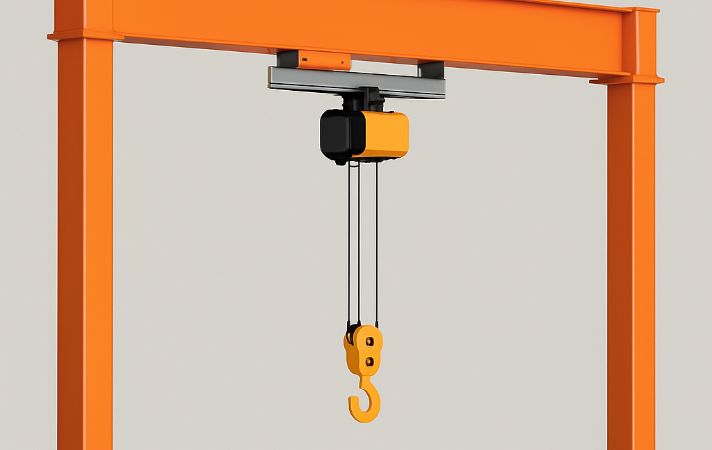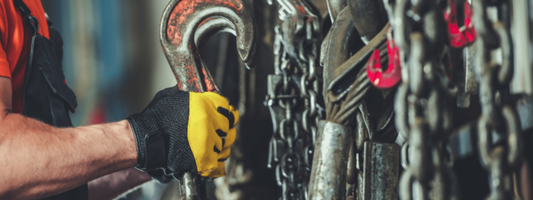
Lifting with Confidence: Why Regular Load Testing Is Essential
In the world of heavy lifting, confidence is everything. Every hoist, crane, and sling in operation carries not just the weight of a load — but the responsibility for safety, compliance, and performance. Regular load testing is the only way to confirm that your lifting systems are up to the task, ensuring that equipment performs safely under the stresses of real-world conditions.
What Is Load Testing?
Load testing is the process of applying a measured load to lifting equipment — cranes, hoists, monorails, and below-the-hook devices — to verify their ability to handle rated capacities safely.
Two primary types of load tests are performed:
-
Static Test – The equipment holds a test load at rest to evaluate structural integrity.
-
Dynamic Test – The load is moved (lifted, lowered, and traversed) to evaluate control, brakes, and motion systems.
According to CSA B167-16, the Canadian standard governing overhead cranes and hoists, new installations, relocated equipment, and major repairs often require testing at 110–125 % of the rated capacity to prove performance.
Why Regular Load Testing Matters
1. Safety First
Equipment failure can lead to catastrophic outcomes — dropped loads, structural collapse, and serious injuries. Controlled load testing identifies weaknesses before they cause incidents.
As noted by Canada Safety Training, proof testing “verifies that lifting equipment is capable of carrying its rated load safely under normal operating conditions.”
2. Compliance with Standards
Canadian employers are required to maintain lifting devices per Occupational Health & Safety legislation and relevant standards.
For example:
-
CSA B167 and ASME B30.2 require load testing after installation, modification, or major repair.
-
WorkSafeBC, Alberta OHS Code, and other provincial regulators mandate certification following “misadventures” or structural changes.
Documented testing provides proof of due diligence — a must for audits, insurance, and safe operations.
3. Equipment Reliability
Routine load testing exposes issues like stretched wire rope, fatigued welds, or failing brakes before they become breakdowns. That means fewer shutdowns, better uptime, and lower repair costs over the life of your lifting system.
Types of Test Loads — and When They’re Used
Not all lifting systems or testing environments are alike. The type of test load used depends on factors such as equipment capacity, environment, accessibility, and precision requirements. Below are the most common load types used across Canada’s industrial and maritime sectors:
1. Water-Filled Load Bags
Water bags have become one of the most widely used test methods for cranes, davits, lifeboat systems, and offshore applications.
Why they’re used:
-
Adjustable load — the exact test weight can be calibrated by controlling the amount of water filled.
-
Lightweight transport — easy to handle and ship when empty.
-
Safety — lower risk of damage to equipment compared to rigid weights if dropped.
-
Commonly used for: Overhead cranes, shipyard cranes, lifeboat davits, offshore platforms, and large hoisting systems.
 2. Solid Steel Test Weights
2. Solid Steel Test Weights
Traditional and still widely used for fixed test facilities or shop-based cranes, solid steel blocks or plates provide an accurate and compact means of testing.
Why they’re used:
-
Consistency and durability — ideal for repeated use and calibration.
-
Precise known weight — often certified and stamped for proof testing.
-
Commonly used for: Workshop overhead cranes, chain hoists, electric wire rope hoists, and testing laboratories.
These weights are the standard for environments where space allows permanent storage and where frequent, controlled tests are conducted.

3. Concrete Test Blocks
Concrete blocks are a cost-effective and stable test option for construction and industrial sites needing a fixed or temporary testing setup.
Why they’re used:
-
Economical — easy to produce in large quantities.
-
Suitable for moderate load capacities where ultra-precise calibration isn’t necessary.
-
Commonly used for: Forklift masts, smaller gantry cranes, and custom lifting frame testing.
However, due to density variation and degradation over time, concrete blocks are generally less precise than steel or water-bag systems.
4. Weighted Barrels or Fabricated Load Frames
In some custom or remote applications, barrels filled with sand, gravel, or lead shot are used for proof load testing of lower-capacity gear such as slings, shackles, or spreader beams.
Portable load frames can also simulate distributed loads for large spreader systems or beams.
Why they’re used:
-
Flexibility for smaller, irregular items
-
Easy to adjust and transport
-
Suitable for on-site demonstrations or mobile test rigs
When and How Often Should You Load Test?
Load testing should be performed:
-
After installation, relocation, or major repair
-
After structural modification or suspected damage (e.g., overload, impact)
-
At manufacturer or regulatory intervals — many crane service providers recommend annual testing for critical operations
Load tests verify the integrity of the crane’s structure and components before returning it to normal service and are a key part of inspection compliance.
Best Practices for Effective Load Testing
✅ Hire qualified technicians — testing must be performed by competent, certified personnel familiar with CSA and ASME standards.
✅ Document every test — include test load weight, duration, method, and results for compliance records.
✅ Use controlled conditions — ensure the load area is clear, taglines are used, and rigging hardware is properly rated.
✅ Inspect before and after testing — confirm integrity of wire rope, hooks, sheaves, and control systems.
✅ Plan for retesting — if deficiencies are found, make repairs and re-certify before returning to service.
Partner with Hercules Crane & Lifting Supplies
At Hercules Crane & Lifting Supplies, we help our clients lift with confidence.
Our certified technicians perform load testing, inspection, and recertification services on cranes, hoists, rigging hardware, and below-the-hook devices in compliance with CSA B167 and ASME B30 standards.
We use a variety of load test systems — from steel weights for precision calibration to water-bag systems for high-capacity and offshore testing — ensuring every piece of lifting gear is certified, compliant, and ready to perform safely.
Our services include:
-
Static and dynamic load testing up to rated capacities
-
Full inspection and maintenance reports
-
On-site and in-shop testing solutions
-
Re-certification for compliance and insurance requirements
When you partner with Hercules, you get more than compliance — you gain peace of mind that your lifting operations are built on a foundation of safety and expertise.
Final Thoughts
Regular load testing is an essential part of responsible lifting operations. It safeguards workers, ensures regulatory compliance, and keeps your cranes and hoists performing reliably day after day. Whether it’s water-bag testing for shipyards or steel weights in your facility, the principle is the same — confidence through verification.
Don’t leave safety to chance.
Contact Hercules Crane & Lifting Supplies today to schedule your next load test and keep your lifting operations strong, safe, and compliant.





